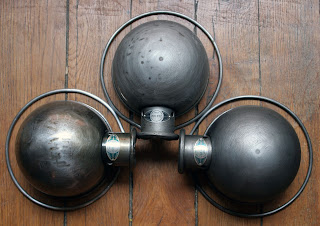Globe Jielde: La finition cirée graphite
Elle a le remarquable avantage de donner un aspect « vieil acier ». Mais il y a finition cirée et finition cirée…
Donc on a décapé, poncé et brossé nos globes. on les a laissé sécher 48 heures. Certains passeront au magasin de bricolage pour acheter un pot de cire graphite noir à patiner. et puis d’autres vont sortir les vieilles casseroles… C’est mon cas.
Je procède en trois ou quatre étapes avec deux cires différentes. La première est une cire de Carnauba très fluide et la deuxième est un mélange cire d’abeille, cire de carnauba et poudre de graphite.
Pour faire une cire on travaille au bain marie pour ne pas bruler la cire et on travaille hors du feu pour ajouter la térébenthine. La cire est très inflammable et la térébenthine aussi, alors on travaille avec beaucoup de prudence.
Pour faire la première on prend une part de cire de carnauba, on la fait fondre au bain marie, on la retire du feu et on y ajoute 20 parts de térébenthine. On mélange bien et on met le tout dans un pot étanche. On continue de mélanger pour éviter que la cire et la térébenthine ne se sépare en refroidissant. La cire présentera un aspect très liquide.
Pour la deuxième on fait fondre un part de cire de carnauba, 4 parts de cire d’abeille et 10 parts d’essence de térébenthine. Même procédure que pour la première à la différence que l’on va ajouter deux cuillères à café de poudre de graphite dans le mélange. On mélange bien jusqu’au refroidissement. Cette cire donnera une pate très onctueuse.
Pour plus d’info sur ces cires n’hésitez pas à me poser des questions. L’explication rapide à ces différentes cires est simple. La cire de carnauba est une cire très dure qui donne un très joli brillant satiné, elle a aussi un point de fusion plus élevé que la cire d’abeille. La cire d’abeille donne des encaustiques très souple et facile à travailler mais donne un toucher un peu collant.
Pour référence, les 3 cires à comparer. De gauche à droite, carnauba, carnauba-abeille-graphite, abeille.
Je procède très simplement pour ce qui suit. Une première couche de cire de carnauba, une couche fine. On laisse sécher 2 ou 3 heures et après on polit. Après on applique une couche fine de cire graphite et on laisse sécher deux ou trois heures, on polit et en fonction de l’aspect désiré on peut repasser une deuxième couche de cire graphite. Et pour le fini, on passe une dernière couche de cire de carnauba. Elle donnera un joli brillant satiné, ne colle pas aux doigts et est antistatique.
De gauche à droite, Un globe après le Rustol, un globe non lustré avec une première couche de cire de carnauba, un troisième globe après sa première couche de cire graphite.



